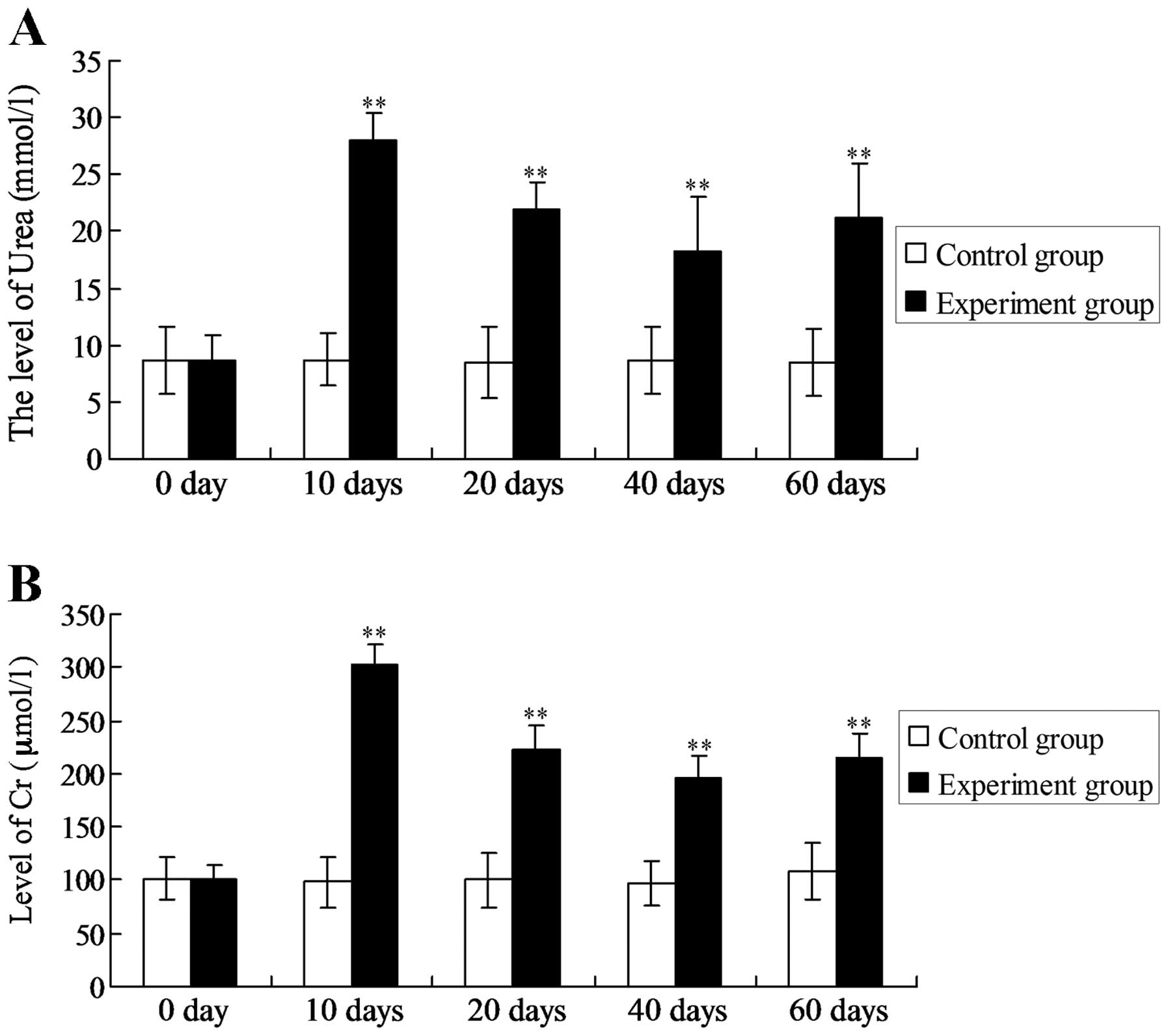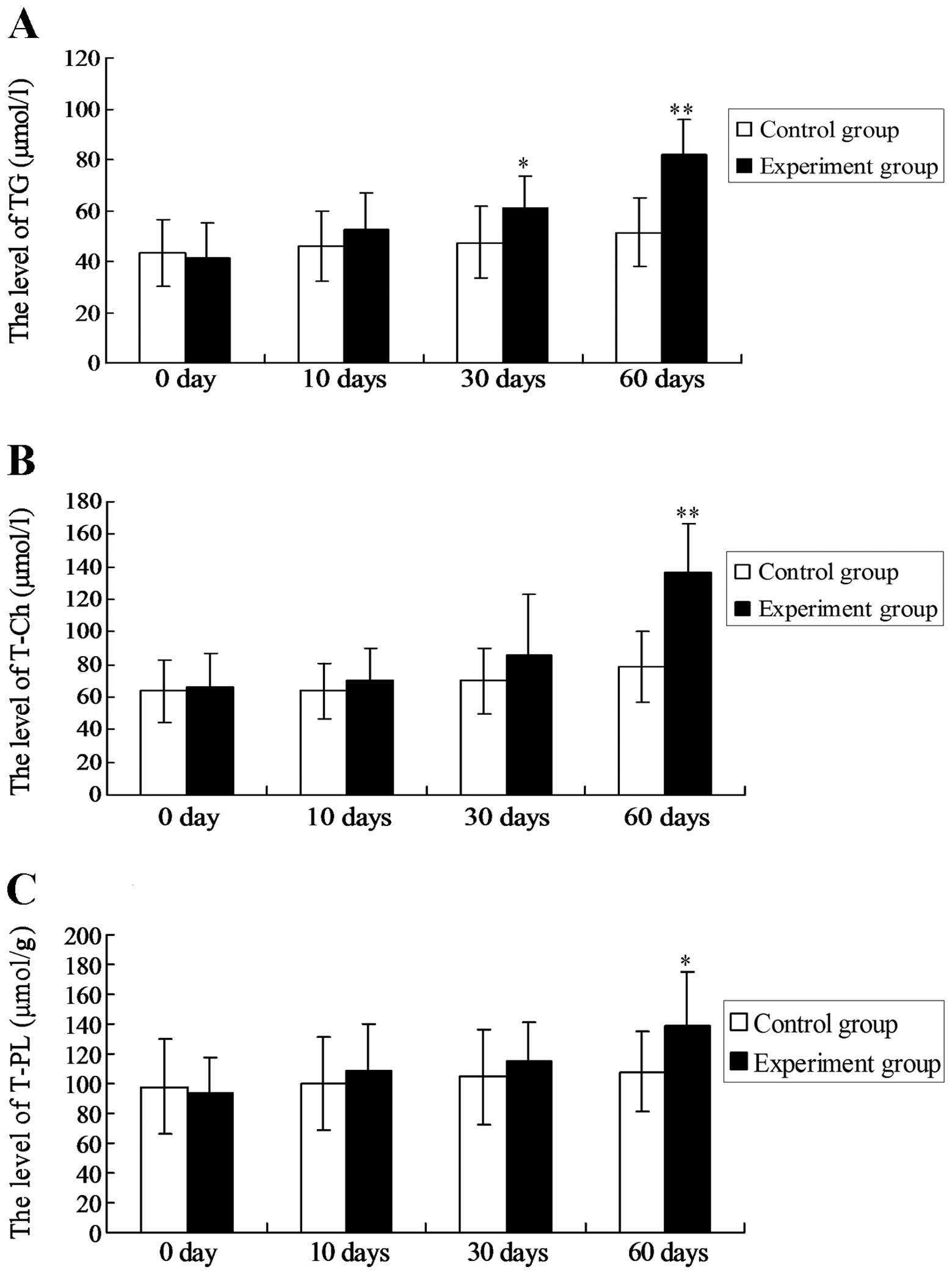|
1
|
Wang L, Wang J, Wang Y, Fu Q, Lei YH, Nie
ZY, Qiu J and Bao TY: Protective effect of exogenous matrix
metalloproteinase-9 on chronic renal failure. Exp Ther Med.
7:329–334. 2014.PubMed/NCBI
|
|
2
|
Bhagwat R, Joshi SP, Salgia P and Sepaha
A: Lipid abnormalities in chronic renal failure. Indian J Clin
Biochem. 12:81–85. 1997. View Article : Google Scholar : PubMed/NCBI
|
|
3
|
Kim HJ, Moradi H, Yuan J, Norris K and
Vaziri ND: Renal mass reduction results in accumulation of lipids
and dysregulation of lipid regulatory proteins in the remnant
kidney. Am J Physiol Renal Physiol. 296:F1297–1306. 2009.
View Article : Google Scholar : PubMed/NCBI
|
|
4
|
Muntener P, Coresh J, Smith JC, Eckfeldt J
and Klag MJ: Plasma lipids and risk of developing renal
dysfunction: the atherosclerosis risk in communities study. Kidney
Int. 58:293–301. 2000. View Article : Google Scholar
|
|
5
|
Caimi G, Carollo C, Montana M, Vaccaro F
and Lo Presti R: Elastase, myeloperoxidase, nitric oxide
metabolites and oxidative status in subjects with clinical stable
chronic renal failure on conservative treatment. Clin Hemorheol
Microcirc. 43:253–258. 2009.PubMed/NCBI
|
|
6
|
Liu N, Tolbere E, Pang M, Ponnusamy M, Yan
H and Zhuang S: Suramin inhibits renal fibrosis in chronic kidney
disease. J Am Soc Nephrol. 22:1064–1075. 2011. View Article : Google Scholar : PubMed/NCBI
|
|
7
|
Han JY, Kim YJ, Kim L, Choi SJ, Park IS,
Kim JM, Chu YC and Cha DR: PPARgamma agonist and angiotensin II
receptor antagonist ameliorate renal tubulointerstitial fibrosis. J
Korean Med Sci. 25:35–41. 2010. View Article : Google Scholar : PubMed/NCBI
|
|
8
|
Suzuki S, Ohashi N and Kitagawa M: Roles
of the Skp2/p27 axis in the progression of chronic nephropathy.
Cell Mol Life Sci. 70:3277–3287. 2013. View Article : Google Scholar :
|
|
9
|
Chen G, Chen H, Wang C, Peng Y, Sun L, Liu
H and Liu F: Rapamycin ameliorates kidney fibrosis by inhibiting
the activation of mTOR signaling in interstitial macrophages and
myofibroblasts. PLoS One. 7:March 28–2012.(Epub ahed of print).
View Article : Google Scholar
|
|
10
|
Pedersen EB, Ardal B, Bech JN, Lauridsen
TG, Larsen NA, Mikkelsen L, Sangill M and Thomsen IM: The effect of
glucose added to the dialysis fluid on blood pressure, vasoactive
hormones and energy transfer during hemodialysis in chronic renal
failure. Open J Neph. 1:5–14. 2011. View Article : Google Scholar
|
|
11
|
Pohjolainen V, Rysä J, Näpänkangas J,
Kööbi P, Eräranta A, Ilves M, Serpi R, Pörsti I and Ruskoaho H:
Left ventricular periostin gene expression is associated with
fibrogenesis in experimental renal insufficiency. Nephrol Dial
Transplant. 27:115–122. 2012. View Article : Google Scholar
|
|
12
|
Mu J, Li YK and Fu SG: Influence of Shenqi
Recipe on mesangial cells and interstitial fibroblasts of chronic
renal failure rats. Zhong Xi Yi Jie He Xue Bao. 1:122–124. 2003.(In
Chinese). View Article : Google Scholar
|
|
13
|
Korish AA and Arafah MM: Catechin combined
with vitamins C and E ameliorates insulin resistance (IR) and
atherosclerotic changes in aged rats with chronic renal failure
(CRF). Arch Gerontol Geriatr. 46:25–39. 2008. View Article : Google Scholar
|
|
14
|
Görs S, Kucia M, Langhammer M, Junghans P
and Metges CC: Technical note: Milk composition in mice -
methodological aspects and effects of mouse strain and lactation
day. J Dairy Sci. 92:632–637. 2009. View Article : Google Scholar
|
|
15
|
Kang NH, Lee WK, Yi BR, Park MA, Lee HR,
Park SK, Hwang KA, Park HK and Choi KC: Modulation of lipid
metabolism by mixtures of protamine and chitooligosaccharide
through pancreatic lipase inhibitory activity in a rat model. Lab
Anim Res. 28:31–38. 2012. View Article : Google Scholar : PubMed/NCBI
|
|
16
|
Wasserman DH, Lacy DB, Goldstein RE,
Williams PE and Cherrington AD: Exercise-induced fall in insulin
and increase in fat metabolism during prolonged muscular work.
Diabetes. 38:484–490. 1989. View Article : Google Scholar : PubMed/NCBI
|
|
17
|
Stoof J, Kuipers EJ and van Vliet AH:
Characterization of NikR-responsive promoters of urease and metal
transport genes of Helicobacter mustelae. Biometals. 23:145–159.
2010. View Article : Google Scholar
|
|
18
|
Lönn J, Shahzad F, Uhlin F, Bengtsson T,
Almroth G and Nayeri F: High concentration but low biological
activity of hepatocyte growth factor in patients with chronic renal
failure. Adv Biosci Biotechnol. 3:516–523. 2012. View Article : Google Scholar
|
|
19
|
Hirako M, Kamiya T, Misu N, Kobayashi Y,
Adachi H, Shikano M, Matsuhisa E and Kimura G: Impaired gastric
motility and its relationship to gastrointestinal symptoms in
patients with chronic renal failure. J Gastroenterol. 40:1116–1122.
2005. View Article : Google Scholar : PubMed/NCBI
|
|
20
|
Sasikala M, Subramanyam C and Sadasivudu
B: Early oxidative change in low density lipoproteins during
progressive chronic renal failure. Indian J Clin Biochem.
14:176–183. 1999. View Article : Google Scholar : PubMed/NCBI
|
|
21
|
Inaguma D, Tatematsu M, Shinjo H, Suzuki
S, Mishima T, Inaba S and Kurata K: Effect of an educational
program on the predialysis period for patients with chronic renal
failure. Clin Exp Nephrol. 10:274–278. 2006. View Article : Google Scholar : PubMed/NCBI
|
|
22
|
Kuwahara M, Inoshita S, Nakano Y, Terada
Y, Takano Y and Sasaki S: Expression of bone type 1 PTH receptor in
rats with chronic renal failure. Clin Exp Nephrol. 11:34–40. 2007.
View Article : Google Scholar : PubMed/NCBI
|
|
23
|
Sadykov AS, Salikhov ShI, et al:
Investigation of membrane-active components from blood serum of
patients with chronic renal failure. Bull Exp Biol Med.
94:1408–1410. 1982. View Article : Google Scholar
|
|
24
|
Markou N, Kanakaki M, et al:
Sleep-disordered breathing in nondialyzed patients with chronic
renal failure. Lung. 184:43–49. 2006. View Article : Google Scholar : PubMed/NCBI
|
|
25
|
Gavrisheva NA, Malinin VV, Ses TP, Kozlov
KL, Panchenko AV and Titkov AY: Effect of peptide Vilon on the
content of transforming growth factor-beta and permeability of
microvessels during experimental chronic renal failure. Bull Exp
Biol Med. 139:24–26. 2005. View Article : Google Scholar : PubMed/NCBI
|
|
26
|
Li P, Ma LL, Xie RJ, et al: Treatment of
5/6 nephrectomy rats with sulodexide: a novel therapy for chronic
renal failure. Acta Pharmacol Sin. 33:644–651. 2012. View Article : Google Scholar : PubMed/NCBI
|
|
27
|
Pusoonthornthum R, Pusoonthornthum P and
Krishnamra N: Calcium-phosphorus homeostasis and changes in
parathyroid hormone secretion in cats with various stages of
spontaneous chronic renal failure. Comp Clin Pathol. 19:287–293.
2010. View Article : Google Scholar
|
|
28
|
Kihara Y, Matsuno N, Mijiti A, Nagao T,
Takeuchi H, Unezaki S and Hirano T: Comparative study of the
cellular pharmacodynamics of calcineurin inhibitors between
patients with chronic renal failure awaiting renal transplantation
and cirrhosis patients awaiting liver transplantation. Cell
Transplant. 18:639–646. 2009.PubMed/NCBI
|
|
29
|
Ienaga K, Mikami H and Yokozawa T: First
indications demonstrating the preventive effects of NZ-419, a novel
intrinsic antioxidant, on the initiation and/or progression of
chronic renal failure in rats. Biol Pharm Bull. 32:1204–1208. 2009.
View Article : Google Scholar : PubMed/NCBI
|
|
30
|
De Beuf A, D’Haese PC and Verhulst A:
Epoetin delta as an antifibrotic agent in the remnant kidney rat: a
possible role for transforming growth factor beta and hepatocyte
growth factor. Nephron Exp Nephrol. 115:e46–e59. 2010. View Article : Google Scholar : PubMed/NCBI
|
|
31
|
Lin Z, Wang JS, Lin L, et al: Effects of
BMP2 and VEGF165 on the osteogenic differentiation of rat bone
marrow-derived mesenchymal stem cells. Exp Ther Med. 7:625–629.
2014.PubMed/NCBI
|











